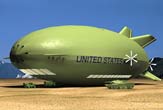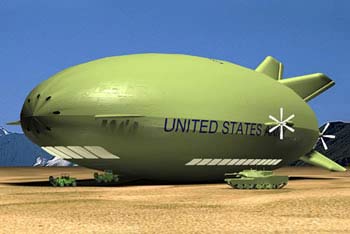The Military's Walrus: An Unlikely Flying Machine

DARPA's Walrus program to develop and evaluate a very large airlift vehicle has moved forward; DARPA announced the contractors for the first phase of the program. Despite detailed early descriptions of "war-balloons" in late nineteenth century science fiction, this isn't your father's (not to mention great-grandfather's) dirigible airship. According to DARPA's press release, "the Walrus aircraft will be a heavier-than-air vehicle and will generate lift through a combination of aerodynamics, thrust vectoring and gas buoyancy generation and management."

The two contractors receiving Walrus phase I awards are:
- Lockheed Martin Corp., Advanced Development Programs, Palmdale, Calif., which will receive $2,989,779
- Aeros Aeronautical Systems Corp., Tarzana, Calif., which will receive $3,267,000
According to DARPA
A key goal of the Walrus program is to establish clear and credible solutions that provide confidence that earlier airship-era limitations will be overcome. In particular, an early focus of the program will be the investigation of advanced breakthrough technologies that will support the development of innovative lift and buoyancy concepts that do not rely on off-board ballast. The Walrus operational vehicle (OV) is envisioned to have the primary operational task of deploying composite loads of personnel and equipment (for example, the components of an Army Unit of Action) ready to fight within six hours after disembarking the aircraft. Walrus will operate without significant infrastructure and from unimproved landing sites, including rough ground having nominal five-foot-high obstacles. It is intended to carry a payload of more than 500 tons 12,000 nautical miles in less than seven days at a competitive cost. Additionally, Walrus will be capable of performing theater lift and supporting sea-basing and persistence missions to meet a range of multi-Service needs.
The idea of using enormous dirigibles for heavy lifting in warfare is not a new idea. In his forgotten 1893 classic The Angel of the Revolution, George Griffith wrote about a coming World War fought with air-ships and war-balloons:
...The war-balloons were to be kept for purposes of transportation of heavy articles to Aeria, while the fleet of air-ships was to remain the sole effective fighting force in the world. (Read more about war-balloons)
Read the DARPA Walrus press release, see the Aeros Walrus description and take a look at a draft copy of DARPA Walrus solicitation (linked from this page).
(This Science Fiction in the News story used with permission from Technovelgy.com - where science meets fiction.)
Sign up for the Live Science daily newsletter now
Get the world’s most fascinating discoveries delivered straight to your inbox.









